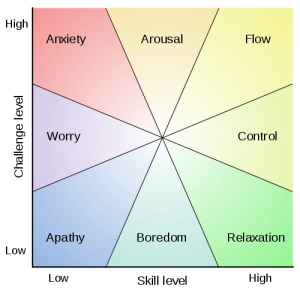
I had never been so proud before, and rarely since.
Staring at the result board, I could only see two names with the highest grades – two people who aced the English university entry exam. I was one of them.
(My future wife was the other one, but that’s another story.)
Let me tell you how it felt when I worked towards it. It’s a personal post, but it’s not about bragging – far from it.
It’s about risk and skill, challenge and pain.
Yeah, mostly about the pain.
Flow: What It Isn’t
A few years ago, this topic was all the rage. Apparently, it was possible to do something so well – so skilfully – that a curious state began to rule your mind. It was possible to get lost in the feeling and the doing, to lost track of time and get some amazing things done.
For a language learner, this must have been amazing news. It was apparently possible to acquire language in this curious state of flow; you could learn faster, better and enjoy this. No more grammar work? No more dull exercises? No more reading? Just this zen-like, disembodied state?
This is what it felt like, when you listened to people describing the benefits of flow.
A few years ago, this was the thing to go for.
Except it’s not quite like that.
Flow: What It Is

Take a look at the illustration opposite. The vertical represents the challenge level; easy tasks would be graded below, challenging ones – towards the top. The horizontal axis is the skill level: towards the left, areas you lack skills in. Towards the right, areas you excel in.
Now focus on the right-hand side. The bottom-right-hand corner is labeled “relaxation”: low challenge, high skill. This is how flow was often misrepresented: all smiles, no worries. Like when Brazil plays soccer against some obscure team, or when a skilled sailor sails his favourite dinghy in a light breeze.
Nice, but not flow. Look above.
High skills, high challenge: this is where to look for flow.
This involves tasks that require you to stretch, and focus, and fail even – before you get in the groove. It involves doing the work, and feeling that it’s going well.
Flow 2001: How It Felt
I spent hours translating grammar problems from Polish to English and back again. I visited a cool, but jaded Bostonian to argue about New York. I listened to hours of recordings and gazed at multiple-choice questions, trying to figure out the implied meanings, allusions and hints.
I spent weeks in trains on my way to the pre-exam course, and in stuffy rooms with too many bored people. I shook off the boredom and had conversations for their own sake.
It was long and arduous. It was expensive. It was a sacrifice (I missed a Pearl Jam concert in my town, so there).
There were no zen-like bells and whistles, no serene environments, no disembodied experiences. There was work, and a lot of it.
Best days of my life? For sure. But not in a way you would imagine.
Flow for Language Learners: Seek It Out
Here’s a hint: if it’s hard, that’s where your flow will be.
Look back on the illustration. What’s the shortest way to get to flow?
It’s not through apathy and boredom – these are dead ends.
It’s rarely through anxiety – this makes you perform too badly.
The good starting point – for any learner – is worry. Go through worry until you get control; then turn up the heat.
How does a language learner do that?
– Ask your language tutor lots of questions.
– Study your texts and handouts at home.
– Take every test, and request them to be properly assessed and commented.
– Request homework, do it, then seek more activities like that.
– Ask for criticism, and take heed.
– Change your school / class / tutor if they go easy on you despite your requests.
– Don’t get ahead of yourself.
– Don’t be ashamed to fail. Expect it, and expect to learn from it.
– Don’t expect to proceed faster, to be moved up a level.
– Appreciate hard, difficult tasks.
– Revise whenever you can.
Most of all: seek out the pain. Look for moments and places which will test your language skills in most uncompromising ways. Go to the country where it’s spoken. Take an exam. Get a job which will require the language from you. Do what isn’t safe, easy or quick.
Flow isn’t for everyone, and not everyone enjoys flow. With the attitude described above, you’ll get there. And then you’ll decide if you want to keep coming back.
Wiktor (Vic) Kostrzewski (MA, DELTA) is an author, translator, editor and project manage based in London. When he works, he thinks about languages, education, books, EdTech and teachers. When he doesn’t work, he probably trains for his next triathlon or drinks his next coffee.
BRAVE Learning (formerly known as 16 Kinds) is a lifelong learning and productivity blog. If you enjoy these posts, please check out one of my books and courses.
My recent publications, and my archive, is now all available on my new project: PUNK LEARNING. Hope to see you there!


4 replies on “The Pain Of Flow: Learning Till It Hurts”
[…] is why you should go. Think about how painful good learning can get. Brush up your note-taking skills. Come to terms with failure. And then […]
[…] Spoken word poetry is accessible: expressing yourself through music, videos or photography may require some extra knowledge, materials or resources. Writing and delivering a poem requires a pen, some paper, your voice and a truckload of courage! Of course it’s hard and potentially painful – but that’s where the learning is, remember? […]
[…] in your head, acknowledge this and move on. Get out of the shock, do something that scares you, let language learning hurt if it has to. If you do this a little at a time, you will get new facts to shut up your lizard brain: “Yes, […]
[…] Foreign languages mess up your brain in wonderful ways. There is no perfect method. You will see where it hurts, how it sucks, why it fails to work. You may not enjoy this. I think we need to be told this. We […]